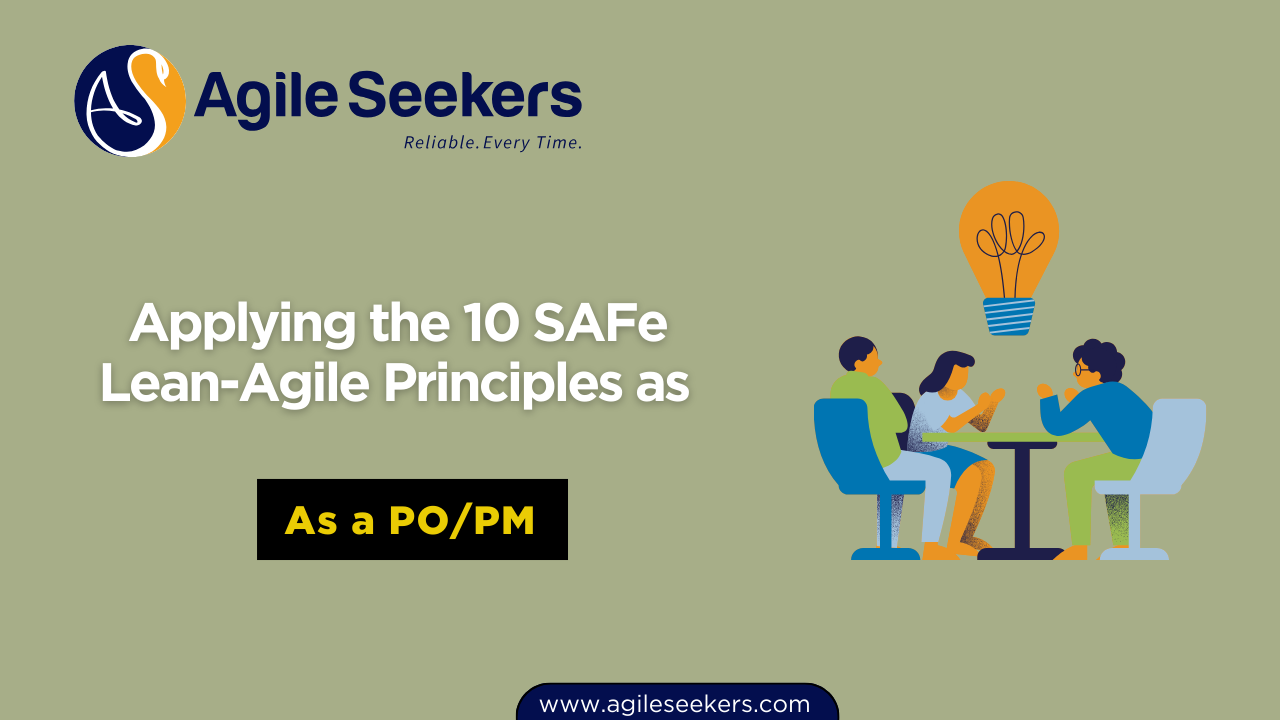Applying the 10 SAFe Lean-Agile Principles as a Product Owner/Product Manager

For a SAFe Product Owner/Product Manager (POPM), the 10 SAFe Lean-Agile principles are not just theory—they’re a roadmap for action. Whether you’re defining features, prioritizing backlogs, or aligning with business goals, these principles guide your day-to-day decisions. Let’s break down how each principle can be translated into clear, actionable behaviors specifically for POPMs.
1. Take an Economic View
As a POPM, you must think beyond functional requirements and ask: “What delivers the best value to the customer and business?” Prioritize features using Cost of Delay (CoD) and Weighted Shortest Job First (WSJF) to ensure high ROI. Embed economic thinking in feature prioritization to balance short-term gains with long-term strategy.
Action Tip: Use WSJF for every PI Planning session. Collaborate with architects and stakeholders to assess real economic impact.
2. Apply Systems Thinking
You’re not building isolated features—you’re building parts of a system. Understanding dependencies and upstream/downstream impacts is essential. Systems thinking helps you recognize how even small changes affect the larger solution and customer experience.
Action Tip: Regularly participate in System Demos and encourage teams to do the same. Map value streams and visualize how your features fit into the system.
3. Assume Variability; Preserve Options
In early development stages, avoid locking into one solution. Encourage exploration and experimentation. Be open to pivoting based on feedback and data.
Action Tip: Frame backlog items with options in mind. Use Enablers to explore technical feasibility before committing to full-scale features.
4. Build Incrementally with Fast, Integrated Learning Cycles
Don't wait until the end of a PI to validate ideas. Build in small batches, gather feedback, and adjust accordingly. This principle encourages you to treat learning as a core part of the development process.
Action Tip: Work closely with Scrum Masters to ensure your team delivers potentially shippable increments every iteration. Track feature progress in Program Boards to maintain transparency.
5. Base Milestones on Objective Evaluation of Working Systems
In the SAFe framework, milestones aren't just dates—they're checkpoints for value delivery. As a POPM, you should push for demos and evaluations that showcase actual working software, not just plans and mockups.
Action Tip: Schedule regular feature demos and use customer feedback to validate business value. Leverage Inspect and Adapt workshops to reflect on outcomes.
6. Visualize and Limit WIP, Reduce Batch Sizes, and Manage Queue Lengths
Clarity comes from visibility. Use Kanban boards and visual tools to track work in progress (WIP). Limiting WIP avoids overloading teams and helps maintain a sustainable pace.
Action Tip: Apply WIP limits at the team and program level. Monitor lead times to detect bottlenecks and manage queue length to improve flow.
7. Apply Cadence; Synchronize with Cross-Domain Planning
Cadence creates rhythm; synchronization aligns diverse teams. As a POPM, your role in PI Planning is vital to ensure alignment across Agile Release Trains (ARTs).
Action Tip: Prepare thoroughly for PI Planning. Align priorities with other POs/PMs and collaborate on a shared vision. Join Scrum of Scrums and PO Syncs to maintain synchronization.
8. Unlock the Intrinsic Motivation of Knowledge Workers
Teams thrive when they feel trusted and empowered. Move away from command-and-control. Instead, focus on enabling autonomy, mastery, and purpose.
Action Tip: Encourage team ownership. Involve them in backlog refinement and decision-making. Celebrate innovation and highlight team wins in ART syncs.
9. Decentralize Decision-Making
Push decisions down to those with the most relevant context. Retain only strategic decisions at the top. This accelerates delivery and boosts accountability.
Action Tip: Empower teams to make local decisions—especially around implementation details. Provide guardrails and context, not micromanagement.
10. Organize Around Value
Don’t just ship software—deliver value. Structure teams and ARTs around the flow of value. Continuously refine the backlog based on evolving customer needs and market signals.
Action Tip: Use customer feedback loops to refine features. Partner with System Architects and RTEs to align delivery with value streams.
From Principle to Practice: Your Daily POPM Checklist
| Principle | POPM Action |
|---|---|
| Economic View | Use WSJF, prioritize based on CoD |
| Systems Thinking | Map dependencies, join System Demos |
| Preserve Options | Explore Enablers before committing |
| Incremental Builds | Deliver MVPs, validate early |
| Objective Milestones | Demo working features, collect feedback |
| Limit WIP | Visualize work, reduce queues |
| Cadence | Prepare for PI Planning, sync with peers |
| Motivation | Empower teams, recognize effort |
| Decentralized Decisions | Push authority to where the knowledge is |
| Organize Around Value | Align features with value streams |
Ready to Put These Principles into Action?
If you’re aiming to master these principles and elevate your impact in a SAFe environment, consider enrolling in the SAFe POPM Certification. The SAFe Product Owner Certification equips you with tools to turn Lean-Agile theory into real-world results. With comprehensive SAFe POPM training, you’ll not only understand these principles—you’ll live them.
Want to compare your options? Check out Scaled Agile’s official breakdown of the 10 Lean-Agile Principles to see how deeply they influence every role, especially the SAFe Product Owner/Manager Certification.
With the right mindset and actionable approach, you can transform your role from a traditional Product Owner to a strategic driver of value across your Agile Release Train. The Lean-Agile principles are your compass—start using them today.




















